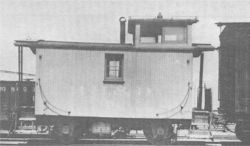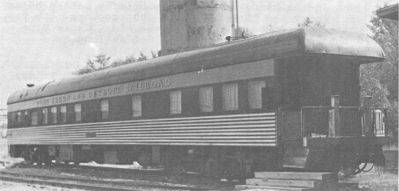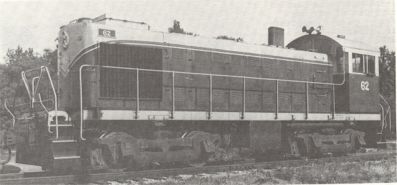- Details
- Hits: 2389
Story - St. Clair County's "Educated" Line
By Jim Anderson, Ann Arbor Train and Trolley Watchers, 1981
The PH&D and How It Got Its Degree
If you drive up Port Huron way from Detroit via the I-94 freeway, you won't spot the busy little Port Huron & Detroit Railroad and, in fact, the little 19-mile line is hard to see by almost any route unless you drive -or even cycle -along the old shore road winding through the picturesque industrial and resort communities of Marine City, St. Clair and Algonac. But, despite its size and the odd name and acronym (more about that later), this shortline is a sterling operation. The PH&D serves several industries that are bunched together and ties into not one but two Class I regional railroad systems, Chessie and Grand Trunk Western.
This railroad-by-the-river was born at the turn of the century in 1900 as the Port Huron Southern and initially covered all of three miles north from the Port Huron Salt Company, its builder and operator, to the big Grand Trunk and Pere Marquette railway junction at Tappan on the southwest side of Port Huron. The salt works was acquired later by the Morton Salt Company and eventually Pere Marquette became part of the Chessie System, a development that many old-time railroaders regarded as a step backward as far as good railroading in Michigan was concerned, recalling the fast and frequent PM service, the beautiful 700 class locomotives, and the husky and handsome 1200 steamers.
Available records of the early years of the line cover all of the important data but are a bit contradictory on detail: three, four and five miles are all given as the initial track mileage. Most accounts go with the three mile maximum and the other trackage may have included sidings and switches. In any case, the track was standard gauge from the start and throughout its history has been well maintained, helped by slow train speeds and locomotives of moderate weight. Accounts vary slightly on the first customers, but fairly soon after operations began service was extended to some of the modest size, heavy industries in Port Huron's South Park, an area which then resembled no park at all with its many grim iron foundries.
In the June 1916 edition of The Official Guide, the Port Huron Southern Railroad Company rated slightly more than three lines, plus title, which pointed out that the railroad was open for freight service only. One interesting point in the tiny announcement was that the president, who was also treasurer, worked out of the Railway Exchange Building in Chicago, surely a long way from his then three to five mile long road.
On December 28, 1917 the Port Huron and Detroit Railroad Company was incorporated and capitalized at the munificent sum of $75,000. Nineteen-seventeen was an auspicious year to launch a railroad. One can point to many significant events in every year, but 1917 had more than its share. The Russian Revolution flared out signaling the advent of the great changes that are impacting the world order even today. Pre-World War I monarchies soon would be crushed. The Far East was changing dramatically. Japan was becoming a power to reckon with and a civil war in China showed that that great and creaky empire was beginning an agonizing process of moving into the twentieth century. There was a lot of railroad news, too, that year, including the worst railroad disaster of all time: the wreck of a troop train in France killed 550 soldiers.
But let's flash back to another ancestor, not quite as direct as the little salt-hauling line in St. Clair County, but nevertheless a major factor in the heritage of the PH&D. At the turn of the century there was a mining company with headquarters in Bay City, Michigan, owned and operated by the energetic Handy brothers. In 1907 the firm decided to build a railroad from Bay City to Port Huron with some spurs running laterally into areas of the "Thumb." Nine year later the line was completed, at least as far as Port Huron, although the Handys apparently intended .to go farther, judging from its name, Detroit, Bay City and Western Railroad Company. Their official station list and mileage table issued in 1920 shows such intriguing station names as Akron Mine Number One, Raby and Ruby, Gravel Pit, Quanicassee and such folksy stops as Snover and Elmer. William N. Boyd, who was the chief engineer for the firm, recalls that the line was built when there was plenty of everything except money. He notes that most of the right-of-way was donated and much of the money raised by residents along the route who needed the transportation. One Henry Heinmiller had a store at Fargo and contributed one thousand dollars worth of groceries, which went to track construction gangs. Doubtless this sum in 1910 would feed more people for considerably longer periods than it would today. A construction project that was prominent in Mr. Boyd's memory years later was a large wooden trestle over Mill Creek at Ruby, eight hundred feet long and eight feet high. At one end a ten-foot cut was needed and when digging started, an old and forgotten cemetery was found with tombstones dating back to 1812, a surprisingly early date for a small in-land Michigan town.
 |
|
ALL STEAMED UP and set for a day's work with engineer Louis Miller is PH&D 37, an ex-P&LE 0-6-0. It's 1937 at Port Huron. (Bob Gray collection). |
The Detroit, Bay City & Western ran two passenger trains daily, for a time; between Bay City and Port Huron, but by the end of the century's second decade truck and auto competition was overwhelming. The line went out of business in the mid-twenties, though a portion survived as the Detroit, Caro and Sandusky under other owners until about 1950.
As indicated by its corporate name, the Handy brothers intended to run a railroad into Detroit, probably a good plan. Traffic from the metropolis would have provided much needed revenue. The route south of Port Huron would be by way of Chesterfield and Mount Clemens where plans were to connect with the Pennsylvania which was then laying rail northward from Toledo to Detroit. The line got only as far as the aforementioned junction at Tappan when it was decided to rollover the PHS and onward from there. But now the Great War to end all wars was about to claim the United States, another partner in a death dance that would see the world forever changed. And the U.S. -with enormous enthusiasm, "Over There, II "The Yanks are Coming, II "We'll Crown the Kaiser With a Bottle of Budweiser," a lot of childlike innocence, and large measures of foolishness -entered the struggle. The U.S. had not experienced a war for some time, not since the badly organized and managed Spanish-American war in 1898 ended so successfully for the Americans in those heady expansionist days. Spain ceded Guam, the Philippines, and Puerto Rico, and we blithely took them without any guilt trips. Moreover, the U.S. came out of that short imbroglio with plenty of war heroes including Teddy Roosevelt and the Rough Riders, and Admiral Dewey. In sum, wars looked easy, fun, and profitable, at least at that time. So when the U.S. declared war on Germany, two decades later, everyone wanted to get into the act. Enthusiasm was about the only thing the U.S. had in abundance. There was a small professional army, small navy, a handful of aircraft, and antiquated weapons. Considerable organization and expansion of war production was needed to match the tremendous growth of the Army which rose to four million men by the end of the war. Some of the decisions made here were terrible; no successful combat aircraft were built that reached France. Tanks and heavy artillery, in fact most war materials, came from our Allies, though the U.S. supplied the most important ingredient for the final victory - fresh manpower.
You may be impatiently wondering, at this point, what all this military history is doing in a railroad article. It's because the PH&D was truly a war baby and a unique one at that. Congress and the Administration moved out briskly to mobilize the railroads. One edict, most well known to steam buffs, was the standardization of locomotive designs.
 |
|
FOUR-WHEEL BOBBER tagged along behind PH&D freights. Port Huron, May 1938. (Hal Jackson photo from Gulash collection). |
Another less well-known was the prohibition of the construction of any new trackage except for spurs into military camps and arsenals. There was one exception --the PH&D. The road was prohibited from building on to Detroit (a survey had been completed and part of the right-of-way purchased) , but permitted to extend to the Marine City sugar plant and the Diamond Crystal Salt plant of St. Clair, and the Banner Salt Company and the Independent Sugar Company of Marine City, Michigan.
These plants were considered to be food producers essential to the war effort. The War Production board made these extensions possible by releasing 2,000 tons of rail that had been rolled for the Russian government and stored at the East Coast Hog Island Shipyard on the east coast which was then mass producing perhaps the ugliest cargo ships ever built called, appropriately enough, "Hog Islanders." In any case, the feeble and soon-to-expire Russian Provisional Government couldn't or wouldn't come up with payment for the steel--they had higher priorities at the time--and the Russian rail was shipped west instead of east. Thus the "only railroad" built during the "Great War" was probably ordered by the Russian Government. Perhaps we could give the railroad still another nickname such as the Trans Siberian Local or the Russian Road.
In 1920, the PH&D bought out the tiny PHS and the line became geographically as it is today. One interesting extension of the railroad was an even shorter "short line" to Algonac Transit Company which operated during the period of 1930 to 1957. There were eight miles of track between Marine City and Algonac hauling freight only and operated by the boat building Chris-Craft Corporation. The little line was locally known for its tiny diesel locomotive with its even tinier awnings. The last trains, which interchanged with the PH&D, ran in September 1957 and the tracks were torn out in October.
The PH&D had some problems with fires during its sixty plus years of existence. In World War II in 1944, a number of freight cars burned while at a siding at the Morton Salt Company and in 1956 the roundhouse and machine shop burned, together with parts, supplies and locomotives. The locomotives were salvaged and rebuilt and the loss was thereby held to $20,000, all covered by insurance.
The initials PH&D attracted some attention from the very start as they so closely followed the abbreviation for a doctor of philosophy. The railroad was eventually tagged with the name "The Intellectual Line." One source recalled some word play on the letters which came out "Poor, Hungry, and Destitute," but that didn't seem to catch on. Railroaders of that era shied away from terms such as destitute and, in any case, the popular view in the Port Huron area was that the road with its broadly diversified industrial clientele was a most prosperous operation, despite the fact that it went bankrupt in 1922. Employees of the railroad were mostly former Pere Marquette and Grand Trunk Western men. They liked the work for the most part, since train crews were home every night and the line rarely worked on Sundays.
 |
|
PH&D business car is usually found parked at the Port Huron roundhouse. |
A fascinating vignette, a commentary on recent times, was built into a Gannett News Service article of March 1, 1973 on hearings by the State Public Service Commission. Mr. George Duffy, then as now, chief officer of the PH&D, gave an upbeat report on the railroad but noted that the Detroit Edison Company had converted most of its generating plants at St. PH&D business car is usually found parked Clair and Marysville from coal to oil. This dropped coal shipments from 13,882 carloads in 1970 to 9,475 in 1972. Duffy stated that Detroit Edison made the conversion for ecological, economical and other reasons. Of course, the almost incredible aspect of it all was the fact that this very same year OPEC made the first of its gargantuan price increases and the "economy" reason for the conversion was only a cruel and expensive joke. We understand that Detroit Edison has now converted most, if not all, of these generators back to coal.
 |
|
PH&D 62, an Alco S-4, was B&O 9084 before coming to the PH&D in early 1974. Roof is light blue, separated from dark blue hood by white and red stripe. Handrails and sill are yellow, undercarriage black. Numeral on cab is white. (Em Gulash photo) |
During these hearings, Duffy reported that the company had 41 employees and a payroll of $515,191, showing a relatively steady work force over many years, probably one of the strengths of this organization. He also noted that economic prospects "looked good for the future years." One most unique aspect of the Scholar's line is that it is the only railroad in Michigan that has a private car (see photo). This great status symbol of the 1890's through the 1920's is currently attracting new interest among railroad aficionados and, while none have been built from the wheels up for some. time, neither are they being wantonly scrapped anymore. The PH&D may also be the nation's shortest railroad to have its own private car. The line also had at least a couple of other "firsts and onlys" with its rolling stock. It was the first railroad in Michigan to go to completely diesel operation--perhaps no great accomplishment for a line this size but still a first--and the PH&D had the first and reportedly only bay window caboose in the area. At least the caboose was the only one seen around these parts for many years and its appearance attracted startled glances from those used to the more conventional types. An odd episode occurred on August 7, 1972, when engine number 60 was taken by an unknown party for a "joy ride." "Fred J. Allen, Marine City, a railroad engineer," wrote the Port Huron Times Herald, "told deputies that whoever took the engine knew what he was doing because several switches that only an authorized railroad person would know about had been turned. It also appeared the engine had been backed into a caboose which was found 150 feet from its initial place on the tracks. Deputies said when the joy ride ended, the engine was taken back to the roundhouse and the doors closed."
A recent Dun and Bradstreet report on the Port Huron & Detroit shows that it is worth about three million dollars, employs 45 people, and is in good condition. The report notes that the road failed in 1922 and was in the hands of receivers briefly before being taken over by current management in 1923. Today the PH&D had about 100 accounts. Oh yes, on the sides of the PH&D's dark blue, white and red boxcars you'll see, "St. Clair Blue Water Route." After all, who ever said that a Michigan Shortline -not as long as a Santa Fe or Burlington Northern, but just as wide -can't have a slogan, too?
As of early March, 1981, PH&D operations now employ two crews on a Monday through Friday basis. Number 9 track in the GTW yards is used to hold cars destined for the PH&D. The Grand Trunk takes cars from this track to the interchange track at Tappan about 9:30pm seven days a week. The PH&D picks up these cars about 1:00 or 1:30pm and then runs down river leaving Port Huron about 2:30pm. At 11:00pm empties are run down river for spotting so that industries can load beginning in the morning with cars returned to PH&D connecting roads in the evening. Besides providing .timely service, this schedule obviously minimizes the imposition of per diem charges. Northbound loads are delivered to the Chessie interchange track located behind the PH&D office and to the GTW interchange about 9:00pm. Marine City revenue largely relates to the Detroit Gasket Company and runs south of St. Clair are only made as traffic warrants, currently about twice per week.
A recent Dun and Bradstreet report on the Port Huron & Detroit shows that it is worth about three million dollars, employs 45 people, and is in good condition. The report notes that the road failed in 1922 and was in the hands of receivers briefly before being taken over by current management in 1923. Today the PH&D has about 100 accounts. Oh yes, on the sides of the PH&D's dark blue, white and red boxcars you'll see, "St. Clair Blue Water Route". After all, who ever said that a Michigan Shortline - not as long as a Santa Fe or Burlington Northern, but just as wide - can't have a slogan, too?
RRHX Editor's Note: The Port Huron & Detroit became a part of the CSX system in the 1980's.
© The Inside Track, all rights reserved.
Bibliography
The following sources are utilized in this website. [SOURCE-YEAR-MMDD-PG]:
- [AAB| = All Aboard!, by Willis Dunbar, Eerdmans Publishing, Grand Rapids ©1969.
- [AAN] = Alpena Argus newspaper.
- [AARQJ] = American Association of Railroads Quiz Jr. pamphlet. © 1956
- [AATHA] = Ann Arbor Railroad Technical and Historical Association newsletter "The Double A"
- [AB] = Information provided at Michigan History Conference from Andrew Bailey, Port Huron, MI

